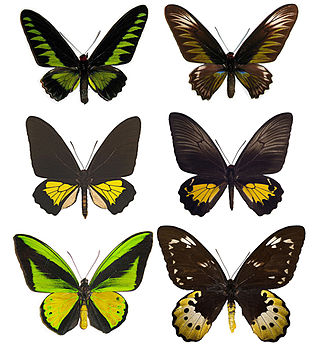Related Research Articles

Swallowtail butterflies are large, colorful butterflies in the family Papilionidae, and include over 550 species. Though the majority are tropical, members of the family inhabit every continent except Antarctica. The family includes the largest butterflies in the world, the birdwing butterflies of the genus Ornithoptera.

Birdwings are butterflies in the swallowtail family, that belong to the genera Trogonoptera, Troides, and Ornithoptera. Most recent authorities recognise 36 species, however, this is debated, and some authorities include additional genera. Birdwings are named for their exceptional size, angular wings, and birdlike flight. They are found across tropical Asia, mainland and archipelagic Southeast Asia, and Australasia.

Rothschild's birdwing is a large birdwing butterfly, endemic to the Arfak Mountains in Western New Guinea.

The giant swallowtail is the largest butterfly in North America. It is abundant through many parts of eastern North America; populations from western North America and down into Panama are now considered to belong to a different species, Papilio rumiko. Though it is often valued in gardens for its striking appearance, its larval stage can be a serious pest to citrus farms, which has earned its caterpillars the names orange dog or orange puppy. The giant swallowtail caterpillars possess remarkable camouflage from predators by closely resembling bird droppings. They use this, along with their osmeteria, to defend against predators such as wasps, flies, and vertebrates.

James John Joicey FES was an English amateur entomologist, who assembled an extensive collection of Lepidoptera in his private research museum, called the Hill Museum, in Witley, Surrey. His collection, 40 years in the making, was considered to have been the second largest in the world held privately and to have numbered over 1.5 million specimens. Joicey was a fellow of the Zoological Society of London, the Royal Geographical Society, the Royal Entomological Society, the Royal Horticultural Society, and the Linnean Society of London.

Ornithoptera paradisea, the paradise birdwing, is a species of birdwing butterfly found in New Guinea.

Ornithoptera victoriae, the Queen Victoria's birdwing, is a birdwing butterfly of the family Papilionidae, found in the Solomon Islands and Papua New Guinea.

Parides klagesi is a species of butterfly in the family Papilionidae. It was thought to be endemic to Venezuela before being discovered in Brazil. A recent, freely available article by Olaf Mielke and Mirna Casagrande (2007) summarizes the known geographical distribution of the species. Because of the prior CITES listing and apparent rarity, this species was placed in the endangered species list for the northern Brazilian state of Pará.

Sir George Hamilton Kenrick FRES was an English entomologist who specialised in Lepidoptera especially those of New Guinea. He was a prominent liberal educationist and was a councillor in Birmingham.
Walther Hermann Richard Horn was a German entomologist who specialised in beetles (Coleoptera). He was born in Berlin, where he also died. He is not to be confused with the American entomologist George Henry Horn who also studied Coleoptera.
Robert Herbert Carcasson was an English entomologist who specialised in butterflies, but also authored two field guides to tropical fishes. He joined the Coryndon Museum, Nairobi, as senior entomologist in 1956. He then became its director, under the museum's new name of the Natural History Museum from 1961 to 1968. During this time he was awarded a PhD for his studies on African hawkmoths. From 1969 to 1971 he was Chief Curator of the Centennial Museum, Vancouver, Canada. In 1972 he travelled in Polynesia, Melanesia, Australia, Malaysia, Sri Lanka, Seychelles and East Africa for production of two field guides to coral reef fish of the Indo-Pacific region. From 1973 to 1979 he was Curator of Entomology at the Museum of British Columbia. He died of cancer. Somewhat a polymath, he was fluent in a number of languages, and produced the illustrations to a number of his works, culminating in hundreds of colour and line drawings of fishes for his reef fish field guides.

George Talbot FES was an English entomologist who specialised in butterflies. He wrote about 150 scientific papers, the majority being primarily systematic, consisting of the description of new species or the revision of various genera. He was also responsible for the curation and preservation of the Joicey collection of Lepidoptera prior to its accession by the Natural History Museum.
Oliver Erichson Janson was an English entomologist who specialised in Coleoptera.

Troides cuneifera, the Mountain Birdwing, is a large butterfly belonging to the swallowtail family, Papilionidae, found in the Thai-Malay Peninsula, Sumatra, Java and Borneo.

Papilio echerioides, the white-banded swallowtail, is a butterfly of the family Papilionidae. It is found in Sub-Saharan Africa.

Papilio hesperus, the black and yellow swallowtail or Hesperus swallowtail, is a butterfly of the family Papilionidae. It is found in Africa.

Papilio desmondi, the Desmond's green-banded swallowtail, is a butterfly of the family Papilionidae. It is found in Africa.
Louis Beethoven Prout (1864–1943) was an English entomologist and musicologist.

Percy Ireland Lathy was an English entomologist who specialised in butterflies. He was an acquaintance of James John Joicey and was associated with Joicey's Hill Museum in Witley, Surrey.
Herbert Jordan Adams was an English entomologist.
References
- ↑ Holland, W. J., 1927. The Lepidoptera named by George A. Ehrmann. Annals of the Carnegie Museum, 17 No.2, Art. 10, Pittsburgh, pp. 299-364.
- Anonym 1926: [Ehrman, G. A.] Annals of the Carnegie Museum, Pittsburgh 16: 351-352
- Holland, W. J. 1926: [Ehrman, G. A.] Entomological News , Philadelphia 37,: 95-96